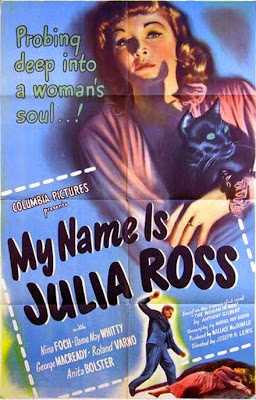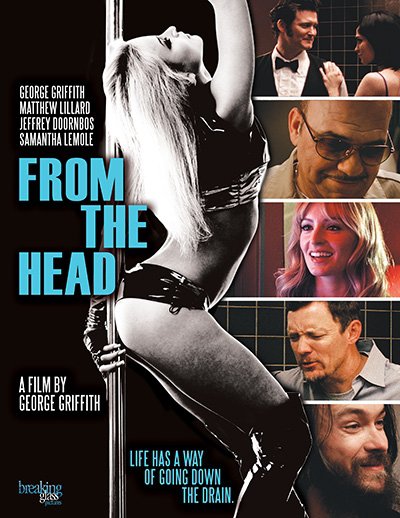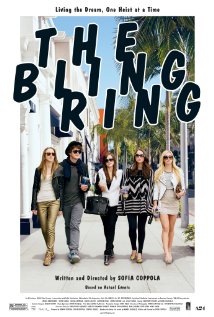The exhibition is set to run at the Design Exchange from June 21 to Sept. 15.
You can read more here.
Black & White and Chic All Over
The exhibition is set to run at the Design Exchange from June 21 to Sept. 15.
You can read more here.
Playing Wednesday, June 19, on TCM
 1:30 p.m. EST (10:30 a.m. PST): “My Name Is Julia Ross” (1945, Joseph H. Lewis). The B-movie prodigy Joseph H. Lewis made two great low-budget noirs: “Gun Crazy,” which almost everyone knows and admires, and the lesser known British-set thriller “My Name Is Julia Ross,” which was a sleeper in its time. It’s a kind of knockoff of the 1944 Ingrid Bergman–Charles Boyer driving-you-crazy suspense drama “Gaslight,” with Nina Foch as the title heroine.
1:30 p.m. EST (10:30 a.m. PST): “My Name Is Julia Ross” (1945, Joseph H. Lewis). The B-movie prodigy Joseph H. Lewis made two great low-budget noirs: “Gun Crazy,” which almost everyone knows and admires, and the lesser known British-set thriller “My Name Is Julia Ross,” which was a sleeper in its time. It’s a kind of knockoff of the 1944 Ingrid Bergman–Charles Boyer driving-you-crazy suspense drama “Gaslight,” with Nina Foch as the title heroine.
She’s a working (or not-working) woman hired for a mysterious job at a seaside Cornish mansion by a rich family (Dame May Whitty, George Macready), who then insist that her name is not Julia Ross, but that she’s instead Macready’s young wife who’s gone insane.
Wonderful mood, images and atmosphere; it’s a crime Lewis didn’t make more films like this.
More of the Noir File is on its way!
From the Head/2013 VoD/Breaking Glass Pictures/95 min.
 Three years at a job can feel like a milestone or a miracle. Working as a bathroom attendant at a seedy strip club, it’s an eternity.
Three years at a job can feel like a milestone or a miracle. Working as a bathroom attendant at a seedy strip club, it’s an eternity.
In “From the Head,” a film made by and starring George Griffith, we spend a day in the life of Shoes, a wry, worldly grifter on his third anniversary of hanging out behind the men’s room door of a Times Square club, drinking, smoking and secretly smirking at patrons as they pause to leave their tips.
We see him interact with customers, joking, advising, observing – even solicitously plucking a stray blonde hair off a man’s suit. Shoes has literary aspirations and all of these moments might be fodder for his work.
The film, impressionistic and candid, snags the harsh look and tawdry feel of the place. Griffith deftly shows the camaraderie among co-workers (shared drinks, a casual display of a brand-new boob job) and seamlessly orchestrates the parade of memorable customers in and out of the men’s room – from the guys who refuse to tip to those who reveal their genuine (mostly unrequited) feelings for the strippers.
Griffith has a gem of an idea here – a sly insider’s view of a “hell hole” fairly bursting with potential for drama. Unfortunately, the film’s drama doesn’t quite get off the ground – despite the tawdry, titillating backdrop, “From the Head” feels oddly flat and sluggish.
Griffith’s main character (Shoes) must distance himself to survive the hostility, sadness and desperation around him, but we don’t get much of a glimpse beyond the wall he has built. The constant cold sneer needs to be tempered by at least a suggestion of vulnerability in order for viewers to feel his depth of pain and connect with his plight.
“From the Head” is available on cable VOD. It releases July 9 on DVD.
By Film Noir Blonde and Mike Wilmington
The Noir File is FNB’s guide to classic film noir, neo-noir and pre-noir from the schedule of Turner Classic Movies (TCM), which broadcasts them uncut and uninterrupted. The times are Eastern Standard and (Pacific Standard).
PICKS OF THE WEEK
“Dark Passage” (1947, Delmer Daves). Friday, June 14: 8 p.m. (5 p.m.)
I recently wrote about 1947’s “Lady in the Lake,” a Raymond Chandler/Philip Marlowe tale, starring and directed by Robert Montgomery. Its chief claim to fame is the experimental subjective camera – the story is told entirely from Marlowe’s point of view.
In that review, I noted that “Dark Passage,” starring Humphrey Bogart and Lauren Bacall, also from 1947, uses a subjective camera as well, though just for the first half-hour of the movie. The limited use of the technique in “Dark Passage” pays off much better than the full-on treatment in “Lady.” Though “Dark Passage” wasn’t a huge hit in its day – audiences weren’t crazy about being deprived of Bogart – it’s a film noir treasure that rarely gets its due.
You can read the full FNB review here.
NOIR WRITERS SERIES: DAVID GOODIS
All this month on its Friday Night Spotlight screenings, TCM is presenting a series of classic film noirs, with each Friday night devoted to movies based on or written by (or both) one of six top-notch noir authors: Dashiell Hammett, Raymond Chandler, James M. Cain, David Goodis, Jonathan Latimer and Cornell Woolrich.
Tonight the spotlight is on David Goodis, one of the strangest and most poignantly self-destructive of the great film noir novelists. Goodis, a well-educated Philadelphian, and an outsider for most of his life, came to Hollywood when his best-selling novel, “Dark Passage” was sold to Warner Brothers as a vehicle for the red hot movie team of Humphrey Bogart and Lauren Bacall. “Dark Passage” allowed Bogie and Bacall to shine, and is now considered a classic.
But Goodis, who liked to explore the lower depths, proved too weird even for Movieland, and he soon returned East where he spent the rest of his relatively brief life (1917-1967) writing pulp novels for paperback publishers, which he occasionally sold to the movies. (See below.)
They were cheap, supposedly trashy books, churned out fast. Goodis filled them with a keen insight into darkness, loneliness and the underworld, a flair for strong perverse characterization and a poetic command of language few writers in his genre could match. “Dark Passage” remains his most famous novel. The most personal and revealing may be “The Burglar,” directed by his Philly friend Paul Wendkos. It’s a powerful film, but the book is better.
(The “Noir Writers” films, all of which show on Friday evening, June 14, were curated and will be introduced by film noir expert Eddie Muller.)
8 p.m. (5 p.m.): “Dark Passage” (See Above.)
10 p.m. (7 p.m.): “Nightfall” (1956, Jacques Tourneur). With Aldo Ray, Anne Bancroft and Brian Keith. Reviewed on FNB, May 29, 2012.
11:30 p.m. (8:30 p.m.): “The Burglar” (1957, Paul Wendkos). David Goodis’ eerie, haunting novel about a gang of burglars, inlcuding platonic lovers Dan Duryea and Jayne Mansfield, and how they come apart. The diretcor, Paul Wendkos (“The Mephisto Waltz”) was another Philadelphia guy and a friend of Goodis’, and he did very well by the book, which is one of the great pulp paperback novels of the ’50s. The movie isn’t on that level, but, in its way, it’s a neglected, if melancholy, gem.
1:15 a.m. (10:15 p.m.): “Shoot the Piano Player” (1960, François Truffaut). The greatest movie ever made from a David Goodis novel is also the ultimate fusion of film noir with the French New Wave. Noir-lover François Truffaut (“Jules and Jim”) takes one of Goodis’ best novels, “Down There,” resets it in a Paris dive, and comes up with melancholy black-and-white movie magic. Truffaut makes the material his own. He keeps the original tale of a concert pianist (legendary torch singer Charles Aznavour) who, heartbroken at the loss of his love, goes down there to the depths of show biz – tinkling the keys in a neighborhood bar, until, despite his best efforts, he falls in love again and falls in with criminals. Like most Goodis stories, it’s a bluesy tale touched with terror. But Truffaut opens it up with innovative filmmaking and breezy, saucy, seemingly off-the-cuff scenes that shoot vibrant life into a very dark subject. [Read more…]
 The Bling Ring/2013/American Zoetrope, et al/87 min.
The Bling Ring/2013/American Zoetrope, et al/87 min.
Writer/director Sofia Coppola (“The Virgin Suicides,” “Lost in Translation,” “Marie Antoinette,” “Somewhere”) has a knack for creating richly textured worlds, capturing the precise look of a place, feeling of a moment and mood of the characters.
In her latest film, “The Bling Ring,” a noirish tale based on real events, the milieu she so deftly depicts is one she presumably knows pretty well from her own experience – a chapter of high school for a group of five privileged kids from suburban Los Angeles. This clique, however, has an unusual gambit for getting a high – they like to steal stuff from celebrities.
These primp-prowl-and-pilfer kids from Calabasas made international headlines in 2009 after breaking into homes and absconding with more than $3 million in jewelry, clothes and accessories from celebrities including Paris Hilton (who appears in the film), Lindsay Lohan, Orlando Bloom, Rachel Bilson and Audrina Patridge. The movie is a fictionalized version of a Vanity Fair feature story (now a book) by Nancy Jo Sales.
After tracking their targets’ whereabouts via gossip and news sites, then finding their addresses on search engines, the gorgeous “gang” nonchalantly sets about quietly letting themselves into these stylish residences, snooping around the celebs’ red-carpet-ready stuff and making off with whatever catches their eyes. Oh and then flaunting their swag, glorious swag, and posting about it on Facebook.
These stunningly self-absorbed Angelenos – played by Emma Watson, Israel Broussard, Claire Julien, Taissa Farmiga and Katie Chang as the brazen ringleader – are observed more than they are judged. Their aberrant behavior, it appears, is fueled by a near-lethal cocktail of hyper-materialism, rampant narcissism, obsession with celebrity (real and fake), hollow spirituality and social media, not to mention actual booze and drugs.
And that constant of high-school angst: a hunger for popularity, attention and belonging. “In ‘The Bling Ring,’ the kids are trying to figure out their identity. I could understand that age and wanting to be part of a group,” said Coppola at a recent event at the Aero Theatre in Santa Monica. “I like stories about people in transition or figuring out their place. I like stories about internal struggle.”
“The Bling Ring,” starts out like a B crime movie – crickets breaking the silence of a peaceful night just before a sleek, secluded home is burgled – but soon sheds any inkling of a low-budget vibe. We are immediately immersed in what feels like a glossy, baffling and fascinating game. It’s hard not to indulge your inner-voyeur. [Read more…]

Image from Entertainment One Films. From left: Joel Edgerton, Teresa Palmer, Felicity Price and Antony Starr.
The Australian thriller/domestic drama “Wish You Were Here,” directed by Kieran Darcy-Smith, opened last weekend in New York and LA. Unfortunately, I found it dull, despite strong performances. You can read the NYT review by Stephen Holden here.
By Film Noir Blonde and Mike Wilmington
The Noir File is FNB’s guide to classic film noir, neo-noir and pre-noir from the schedule of Turner Classic Movies (TCM), which broadcasts them uncut and uninterrupted. The times are Eastern Standard and (Pacific Standard).
PICK OF THE WEEK
“Detour” (1945, Edgar G. Ulmer). Tuesday, June 11: 2:45 p.m. (11:45 a.m.).
Luck so bad it borders on absurd, a story as flimsy as cardboard, a femme fatale who’s downright feral. That would be 1945’s “Detour,” a B classic that director Edgar Ulmer shot in less than a month for about $30,000.
Despite these limitations (or maybe because of them) Ulmer manages to work some visual miracles. Those foggy scenes where you can’t see the street? He didn’t have a street so he filled in with mist. Born in what is now the Czech Republic, Ulmer came to the US in 1923. He brought a high-art, painterly disposition to this tawdry little flick, as he did to most of his work.
You can read the full FNB review here.
Friday, June 7
11:15 a.m. (8:15 a.m.): “Stranger on the Third Floor” (1940, Boris Ingster). With Peter Lorre, Margaret Tallichet and Elisha Cook, Jr. Reviewed on FNB Nov. 3, 2012.
NOIR WRITERS SERIES: DASHIELL HAMMETT
All this month, on its Friday Night Spotlight screenings, TCM will show a series of classic film noirs – with each Friday devoted to movies based on or written by (or both) one of four top-notch noir authors – Dashiell Hammett, Raymond Chandler, James M. Cain and Cornell Woolrich.
Tonight the spotlight is on the matchless hard-boiled crime writer Dashiell Hammett – who, along with Ernest Hemingway, was probably one of the most influential American writers of the decades after World War I, and since. Terse, lean and brutally direct, empty of flourish, cliché or artifice, Hammett’s style owed a lot to his own years as a Pinkerton detective.
He decisively reveals a world of greed, murder, illicit sex, gangsterism, corruption and treachery among the rich and the crooked, telling it all with a flair and a punch that was copied endlessly but rarely recaptured. (The “Noir Writers” films were curated and will be introduced by film noir expert Eddie Muller.)
8 p.m. (5 p.m.): “The Maltese Falcon” (1931, Roy Del Ruth). The first movie adaptation of Hammett’s classic dark private-eye novel, with Ricardo Cortez as Sam Spade, Bebe Daniels as the femme fatale and Dudley Digges as Gutman – all chasing the priceless black bird. It pales beside John Huston’s great version of course (see below). But it’s not bad, in a raunchy pre-Code way.
9:30 p.m. (6:30 p.m.): “City Streets” (1931, Rouben Mamoulian). Hammett’s only original movie story: an underworld romance stylishly directed by Mamoulian, who was in his most innovative period. With Gary Cooper and Sylvia Sidney as lovers caught in a vicious world of big-city crime, and Paul Lukas and Guy Kibbee as off-type bad guys. [Read more…]
Having just seen “The Bling Ring,” Sofia Coppola’s terrific new neo-noir based on real events, I am especially excited about An Evening with Sofia Coppola, presented by the American Cinematheque.
The night begins with 2003’s “Lost in Translation,” starring Bill Murray and Scarlett Johansson, as two Americans who cross paths one night in a luxury hotel bar in Tokyo and form an unlikely friendship. The film earned Coppola an Oscar for Best Original Screenplay.
Next up is “The Virgin Suicides,” Coppola’s adaption of Jeffrey Eugenides’ novel exploring adolescent repression and rebellion in an upper-class Detroit suburb in the 1970s. The local boys are mesmerized by the mysterious Lisbon sisters, who are kept on a short leash by overprotective parents James Woods and Kathleen Turner. When one of the girls (Kirsten Dunst) strikes up a relationship with one of the guys (Josh Hartnett), it sets in motion a chain of events that ends in tragedy.
There will be a discussion between films with Coppola.
An Evening with Sofia Coppola takes place on Wednesday, June 5 at 7:30 p.m. at the Aero Theater in Santa Monica.
On Saturday, I attended an elegant and lively double-bill soiree: the opening of Francisco Zúñiga: A Centennial Tribute at Jack Rutberg Fine Arts in Los Angeles and an anniversary party for the always-inspiring arts·meme blog, founded five years ago by Debra Levine.
Debra is a former dancer whose grace and poise extends to her writing as well to welcoming guests. She has the old-school and thoroughly charming notion that partygoers might enjoy being introduced to one another. Imagine! There were many to greet on Saturday and Debra did the job nimbly, flitting from person to person, smiling brilliantly, flirting sometimes, briefly quizzing, then nodding, pondering and promising to give her considered reply later on.
There is another arrival and, as always, party clocks shoo the minutes into a lovely over-too-fast blur. Meshuga, she often calls herself. Those who know her call her savvy, sharp, insightful and delightful. Thank you, Debra, for a wonderful party and happy anniversary to arts·meme.
Francisco Zúñiga: A Centennial Tribute at Jack Rutberg Fine Arts runs through July 31.

Copyright © 2025 · Genesis Framework · WordPress · Log in
From FNB readers